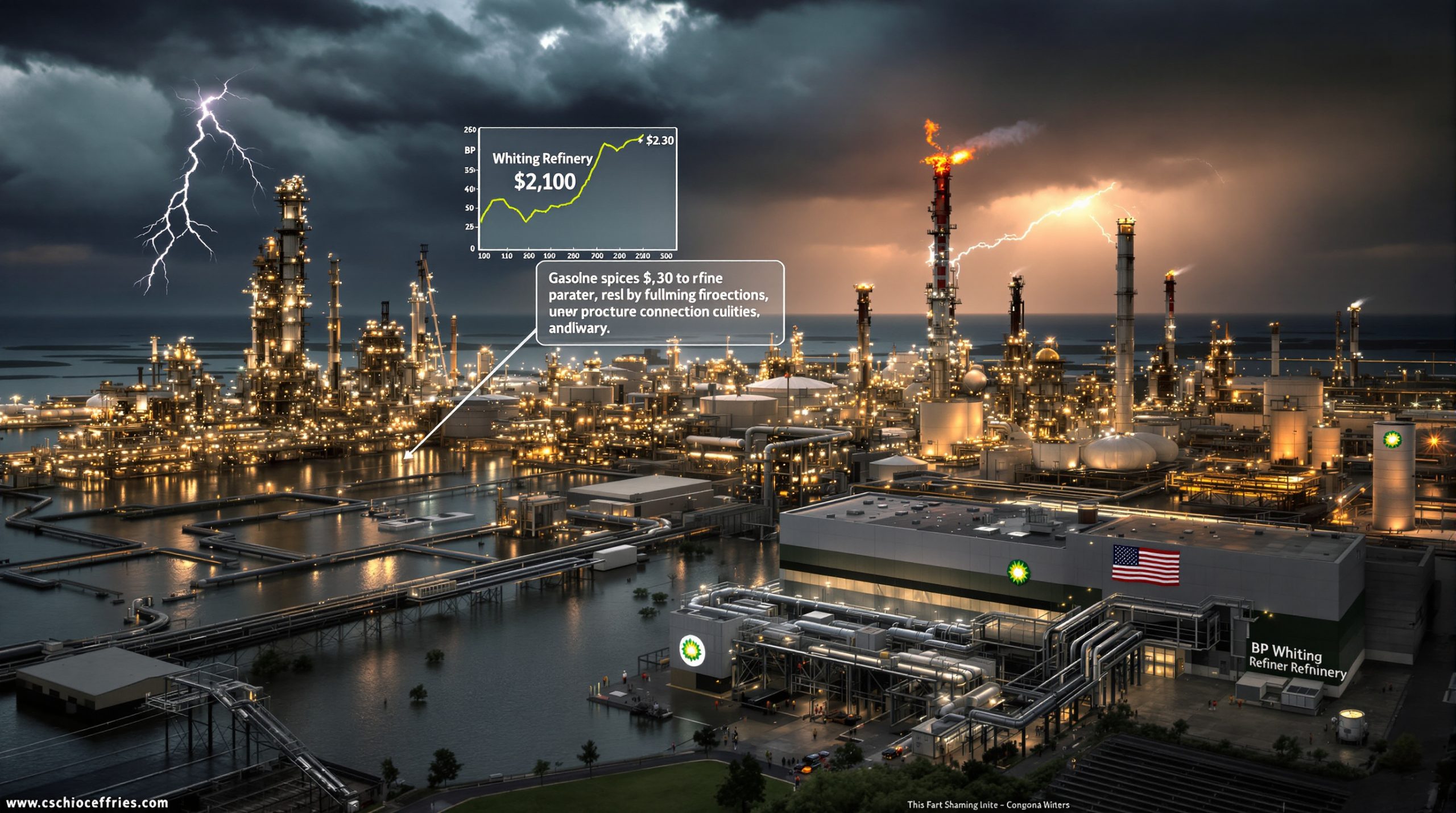Why Is Eric Nuttall Predicting an Oil Glut Now and a Bull Market in 2026?
The global oil market is experiencing significant shifts in supply and demand dynamics that could lead to a period of oversupply before transitioning to a potential bull market. Eric Nuttall, partner at Ninepoint Partners and a prominent energy fund manager, recently expressed bearish sentiments for the remainder of 2025 while forecasting a major bull market developing by 2026. Let's examine the factors behind these contrasting short-term and medium-term outlooks and what they mean for energy investors.
Understanding the Current Oil Market Dynamics
The current oil market is characterized by increasing production from multiple sources while demand growth remains relatively stable. This imbalance is creating downward pressure on prices that could persist in the near term.
"We have a surge of OPEC production between now through September. We've got the normalization and the end of that voluntary deal. That's 1.2 million barrels per day that the market is having to absorb," explains Nuttall in his recent interview with BNN Bloomberg.
This surge in supply comes at a time when seasonal factors are beginning to shift, creating a perfect storm for a temporary supply glut. With Brent crude trading around $66.88 per barrel and WTI at approximately $63.35 per barrel (as of August 2025), the market is reflecting these oversupply concerns.
The oil market has always been cyclical, but the current dynamics suggest we're entering a particularly interesting phase where short-term bearishness may be setting the stage for a significant bull run in the medium term.
What Factors Are Creating the Near-Term Oil Glut?
Several key factors are contributing to the current oversupply situation in global oil markets, creating downward pressure on prices that could persist through late 2025.
OPEC+ Production Increases
OPEC and its allies have significantly ramped up production in recent months, adding more than 500,000 barrels per day to global supply. This surge comes as the organization rolls back voluntary production cuts that had previously helped stabilize prices.
The market must now absorb approximately 1.2 million additional barrels per day as these voluntary agreements end. This substantial increase in supply is occurring at a time when demand growth is not keeping pace, creating an imbalance that is pressuring prices.
Saudi Arabia, the de facto leader of OPEC, has shown willingness to increase production despite softening prices, suggesting strategic considerations beyond short-term price stability.
Seasonal Demand Fluctuations
Seasonal factors are playing a significant role in the current market imbalance:
- Saudi Arabia is reducing direct oil burn for power generation as summer ends
- Refineries are entering maintenance season beginning in September
- Gasoline demand typically decreases after the summer driving season
- Heating oil demand has not yet ramped up for winter
These seasonal shifts typically lead to temporary inventory builds during the transition periods between peak demand seasons.
As Nuttall points out: "There's been a mismatch between the increase in production from OPEC and the increase in exports, because during the summertime, a lot of countries, namely Saudi, burn oil for air conditioning. Well, that's coming to an end."
New Production Sources Coming Online
Several major offshore projects have recently increased global supply, adding to the oversupply situation:
- Guyana's production has surged to over 900,000 barrels per day with ExxonMobil's fourth floating production unit now operational
- Brazil has reported significant new discoveries, including BP's largest oil and gas discovery in 25 years
- U.S. production remains resilient despite relatively lower prices
These new sources add substantial volumes to an already well-supplied market. The Guyana development is particularly noteworthy as it represents one of the most significant new oil provinces discovered in decades, with production ramping up faster than many analysts initially expected.
The Brazilian discoveries also highlight how technological advancements continue to unlock resources that were previously inaccessible or uneconomic, adding to global supply even in a moderate price environment.
Current Price Environment
Oil prices reflect these market conditions with:
- Brent crude trading around $66.88 per barrel (as of August 2025)
- WTI crude at approximately $63.35 per barrel
- Discount spreads widening between benchmarks and physical grades
These oil price movements suggest oil equities are fairly valued in the near term, according to Nuttall's analysis. While not catastrophically low, these prices represent a significant pullback from peaks seen in recent years.
Why Does Nuttall Predict a Bull Market in 2026?
Despite the bearish near-term outlook, Nuttall sees "the seeds of the next bull market" taking root by 2026. Several structural factors support this view of a tightening market beyond the current oversupply situation.
Absorption of OPEC+ Spare Capacity
The current production increases from OPEC+ will gradually reduce the organization's spare capacity, limiting its ability to respond to future supply disruptions or demand increases.
As this buffer of available production capacity diminishes, the market becomes more vulnerable to supply shocks. Saudi Arabia, which traditionally maintains the largest spare capacity cushion, may find its ability to respond to market tightness diminished after the current production increase.
This diminishing buffer creates potential for price volatility and upward pressure as the market loses its security blanket against disruptions.
South American Production Stabilization
While new production from Guyana and Brazil is currently pressuring prices, these sources will eventually be absorbed by the market as:
- Initial production surges stabilize as projects reach plateau rates
- Natural decline rates in existing fields offset some new production
- Development timelines for subsequent phases extend beyond the current oversupply period
- Global demand continues its long-term growth trajectory
The production profiles of offshore developments typically include an initial ramp-up followed by a plateau and then natural decline. By 2026, many of the current new developments will have moved past their initial surge phase.
Underinvestment in New Production
The energy transition has led to reduced capital expenditure in new oil projects globally. This underinvestment creates a situation where:
- Existing fields face natural production declines of 4-5% annually
- Replacement capacity isn't being developed at sufficient rates
- Long lead times for major conventional projects mean today's investment decisions affect supply 3-5 years later
- Financial institutions have reduced funding for fossil fuel projects
The supply-demand balance could tighten significantly by 2026 as the effects of years of underinvestment become apparent. Unlike previous cycles, the current restraint in capital spending appears more structural than cyclical, driven by energy transition pressures and investor demands for capital discipline.
Geopolitical Risk Premium
Ongoing tensions, including sanctions on Russian crude, continue to support a risk premium in oil prices. While this prevents traders from becoming fully bearish now, it also creates potential for price spikes if geopolitical situations deteriorate.
By 2026, several geopolitical factors could further impact supply:
- Evolution of Russian export capabilities under prolonged sanctions
- Middle East tensions affecting key maritime chokepoints
- Political stability in major producing regions
- Policy changes in consuming nations affecting demand patterns
These factors add another layer of complexity to the supply picture and could accelerate the transition to a bull market if disruptions occur.
How Are Current Market Conditions Affecting Energy Investments?
The current market environment presents both challenges and opportunities for energy investors, with differing outlooks for oil and natural gas investments.
Oil Equities Valuation
At current price levels, oil equities appear fairly valued according to Nuttall's analysis. This suggests limited near-term upside in the oil sector despite relatively healthy cash flows at current price levels.
Many oil companies have:
- Strengthened balance sheets following the recent period of higher prices
- Implemented share buyback programs to return capital to shareholders
- Maintained capital discipline rather than aggressively pursuing growth
- Increased dividend payouts to attract yield-focused investors
These factors provide some downside protection but may limit upside potential until the supply-demand balance tightens.
Natural Gas Opportunities
Nuttall identifies greater near-term investment opportunities in natural gas compared to oil. He specifically highlights Calgary-based Expand Energy as a preferred investment with:
- Free cash flow yields of approximately 14%
- Dividend yields above 3%
- Potentially undervalued assets compared to peers
- Exposure to favorable US natural gas forecast fundamentals
Natural gas markets operate with different fundamentals than oil, with more regional pricing and less influence from OPEC+ production decisions. This creates opportunities for astute investors to find value even when oil markets are under pressure.
Investment Strategy Implications
For investors considering the energy sector, these market dynamics suggest:
- Caution on oil-focused investments in the near term
- Potential opportunities in natural gas and select energy companies with strong balance sheets
- Focus on companies with low breakeven prices that can remain profitable in the current environment
- Positioning for the anticipated bull market in 2026 by identifying quality companies that can weather the current oversupply period
Investors might consider a barbell strategy: maintaining some exposure to high-quality oil producers that can withstand the near-term pressure while allocating capital to natural gas opportunities that offer more immediate upside potential.
What Key Metrics Should Investors Monitor?
Navigating the transition from oil glut to potential bull market requires monitoring several key metrics that provide early indications of market direction.
Inventory Levels
Global oil inventory levels provide crucial insights into market balance:
- Current expectations point to inventory builds through late fall 2025
- Strategic petroleum reserves (SPR) levels in major consuming nations
- Commercial crude oil inventories in OECD countries
- Floating storage volumes on tankers
The rate and duration of these builds will indicate the severity of the oversupply. Inventory drawdowns would signal an earlier-than-expected market rebalancing and potentially accelerate the timeline to a bull market.
Particularly important are inventory levels relative to 5-year averages, as significant deviations provide context for how unusual the current situation is compared to historical patterns.
OPEC+ Production Decisions
Future OPEC+ meetings and production decisions remain critical:
- Any reversal of the current production increases would support prices
- Further increases would exacerbate the oversupply situation
- Changes in Saudi Arabia's production strategy often signal broader OPEC+ intentions
- Compliance rates among OPEC+ members with agreed quotas
OPEC+ has demonstrated willingness to adjust production targets in response to market conditions. Monitoring their formal statements as well as unofficial signals from key members can provide valuable insights into future supply trends.
Demand Indicators
Several demand indicators provide early warnings about market direction:
- Chinese oil import volumes and refinery utilization rates
- U.S. gasoline consumption patterns
- Global air travel recovery and jet fuel demand
- Industrial activity in major economies
- Electric vehicle adoption rates and their impact on gasoline demand
Demand surprises, either positive or negative, could significantly alter the timeline for market rebalancing. Particular attention should be paid to China, which remains the largest source of incremental oil demand growth globally.
Geopolitical Developments
Monitoring geopolitical situations that could impact oil supply:
- Developments in Russia-Ukraine relations
- Middle East tensions and production disruptions
- Sanctions policies under current administrations
- Venezuelan production and export capabilities
- Political stability in key African producing nations
Sudden supply disruptions due to geopolitical events could rapidly shift the market from oversupply to balance or even deficit, potentially accelerating the bull market timeline.
How Might the Market Transition from Glut to Bull?
The transition from the current oversupply to a potential bull market will likely follow a sequence of market adjustments as various forces come into balance.
Potential Catalysts for Market Rebalancing
Several factors could accelerate the transition from oversupply to tight markets:
- Unexpected production outages in major producing regions
- Stronger-than-anticipated demand growth, particularly from emerging economies
- OPEC+ policy adjustments in response to falling prices
- Acceleration of natural decline rates in existing fields
- Weather events affecting production or consumption patterns
These catalysts could individually or collectively tip the balance from oversupply to deficit, potentially ahead of the 2026 timeline suggested by Nuttall.
Timeline for Market Evolution
The progression from current conditions to a bull market might follow this pattern:
- Remainder of 2025: Inventory builds and price pressure
- Early 2026: Stabilization as seasonal factors reverse
- Mid-2026: Gradual tightening as demand growth absorbs excess supply
- Late 2026: Potential bull market conditions as spare capacity diminishes
This timeline assumes no major geopolitical disruptions or demand shocks. Any significant deviation from expected supply or demand trends could accelerate or delay this progression.
The transition will likely be signaled by changes in the futures curve structure, with potential shifts from contango (where future prices are higher than spot) to backwardation (where spot prices exceed futures prices) indicating tightening physical markets.
Price Projection Considerations
While specific price targets are speculative, the following factors suggest significant upside potential by 2026:
- Limited new production capacity coming online after current projects
- Ongoing capital discipline among major producers
- Potential acceleration of energy transition investments requiring healthy cash flow from traditional operations
- Geopolitical risk premiums in a tightening market
The magnitude of any price increase would depend on the severity of the supply-demand imbalance and the market's perception of how structural or temporary that imbalance might be.
Historical oil bull markets have seen price increases of 50-100% from cycle lows, though each cycle has unique characteristics that make direct comparisons challenging.
What Are the Implications for Energy Markets Beyond Oil?
The dynamics affecting oil markets have broader implications for the entire energy complex, creating interconnected opportunities and challenges.
Natural Gas Market Dynamics
The natural gas market operates with different fundamentals than oil:
- Regional pricing rather than global benchmarks
- Infrastructure constraints limiting global arbitrage
- Growing LNG trade gradually connecting regional markets
- Seasonal demand patterns creating volatility
- Increasing role as a transition fuel in power generation
These differences explain why Nuttall sees greater near-term opportunity in natural gas investments despite bearishness on oil. Natural gas demand has shown more resilience and growth potential, particularly as coal-to-gas switching continues in many markets.
The LNG market continues to evolve, with new export and import facilities gradually creating a more interconnected global market. However, regional price disparities persist due to transportation costs and infrastructure limitations.
Energy Transition Considerations
The broader energy transition continues to influence investment decisions:
- Oil companies diversifying into renewable energy and low-carbon technologies
- Natural gas positioning as a transition fuel with growth potential
- Increasing focus on carbon intensity of production
- ESG considerations affecting capital allocation decisions
- Policy support for alternative energy sources creating competition
These factors create a complex landscape where traditional energy companies must balance near-term cash generation from fossil fuels with longer-term positioning for a lower-carbon future.
The energy transition's pace remains uncertain, creating both risks and opportunities for conventional energy producers. Companies that can maintain operational excellence in traditional assets while developing capabilities in emerging energy technologies may be best positioned for long-term success.
Integrated Energy Company Strategies
Major energy companies are adapting to these changing market conditions by:
- Maintaining capital discipline in traditional oil and gas operations
- Focusing on low-cost, high-margin production assets
- Gradually increasing investments in lower-carbon businesses
- Returning capital to shareholders through dividends and buybacks
- Optimizing portfolios to improve resilience to price volatility
These strategies reflect the industry's recognition that the energy landscape is evolving, requiring both near-term profitability and long-term adaptability.
The most successful companies will likely be those that can generate strong returns in the current environment while positioning themselves for future changes in energy markets.
FAQ: Oil Market Outlook 2025-2026
Why is OPEC increasing production despite weak prices?
OPEC members may be increasing production to maintain market share, generate needed revenue, or position themselves strategically before potential market tightening. The organization might also be testing market resilience and price floors.
Many OPEC nations rely heavily on oil revenue for government budgets and may prioritize volume over price when fiscal pressures mount. Additionally, concerns about losing market share to non-OPEC producers like the United States, Brazil, and Guyana could motivate higher production even at lower prices.
How might geopolitical tensions affect the oil market forecast?
Geopolitical tensions create both upside and downside risks. Sanctions, conflicts, or production disruptions could quickly tighten markets, while diplomatic breakthroughs or policy changes could release additional supply.
The oil market has historically incorporated a risk premium during periods of heightened geopolitical tension. This premium can increase or decrease rapidly in response to evolving situations, creating price volatility independent of fundamental supply-demand balances.
What role will U.S. shale play in the 2026 market outlook?
U.S. shale producers have demonstrated capital discipline in recent years, focusing on returns rather than growth. Their response to higher prices in 2026 will be crucial—rapid production increases could moderate a bull market, while continued discipline would support higher prices.
The shale sector has undergone significant consolidation, potentially changing its collective response to price signals. Larger, integrated companies now control a greater percentage of shale assets and may prioritize steady returns over aggressive growth, even in a higher price environment.
How do seasonal factors affect oil market balances?
Seasonal patterns significantly impact oil markets, with higher demand during summer driving season and winter heating season. Refinery maintenance periods in spring and fall typically see inventory builds as processing capacity temporarily decreases.
These seasonal patterns create predictable cycles in inventory levels and sometimes prices. However, the magnitude of these seasonal effects can vary based on weather patterns, economic conditions, and changes in consumer behavior.
What indicators would signal an earlier-than-expected bull market?
Key indicators of an accelerating bull market would include:
- Consistent inventory draws outside normal seasonal patterns
- OPEC+ struggling to meet production targets
- Rapid demand growth in emerging economies
- Declining production from mature basins exceeding expectations
- Futures curves moving into steeper backwardation
These signals would suggest that the market is tightening more quickly than anticipated, potentially bringing forward the bull market timeline from 2026.
Navigating the Oil Market's Transition
The oil market appears headed for a period of oversupply and inventory builds through late 2025, creating near-term headwinds for prices and energy equities. However, the fundamental factors driving this oversupply—particularly OPEC+ production increases and new offshore developments—are likely temporary.
By 2026, market dynamics could shift dramatically as spare capacity diminishes, underinvestment in new production becomes apparent, and demand growth absorbs the current excess supply. This transition creates both challenges and opportunities for energy investors, requiring careful positioning to weather near-term pressures while preparing for potential upside.
The contrasting short-term bearish and medium-term bullish outlook highlights the cyclical nature of commodity markets and the importance of looking beyond immediate conditions when developing investment strategies in the energy sector.
As Eric Nuttall suggests, investors may find better near-term opportunities in natural gas while positioning for the potential oil price forecast bull market in 2026. Understanding the factors that could accelerate or delay this transition will be crucial for successful energy investing in the coming years.
Furthermore, the expected US oil production decline by 2025 could further exacerbate the tightening market conditions that Nuttall anticipates. Recent Alaska policy shift developments regarding oil and gas drilling may also play a role in the longer-term supply outlook, potentially contributing to the bull market scenario that Nuttall envisions for 2026.
Disclaimer: This article contains forecasts and market analysis that should not be considered investment advice. All investments involve risk, and past performance is not indicative of future results. Readers should consult with a qualified financial advisor before making investment decisions based on the information presented.
Want to Be Alerted to the Next Big Mineral Discovery?
Discovery Alert's proprietary Discovery IQ model provides instant notifications of significant ASX mineral discoveries, giving you the edge in both short-term trading and long-term investment opportunities. Visit the discoveries page to see why historic discoveries can generate exceptional returns and begin your 30-day free trial today.




